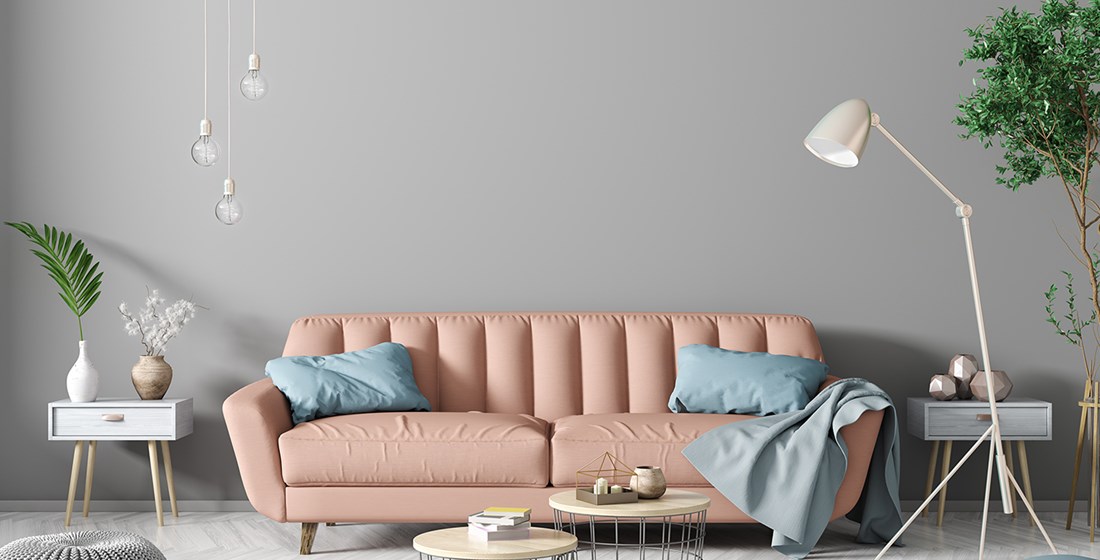Light up - lighting solutions for grey days
- Go back
- 25th Jan 20

The weather outside might be frightful but there are ways to bring warmth into your home with some cleverly placed lighting solutions. From the ambience and mood of a room to creating the illusion of more space, don’t overlook lighting when thinking about your interior design.
Create layers of light
Designers will create multiple layers of light sources in each room to give the desired effects. Overhead, accent and task lighting will often all be found and used at different times of the day and night. The goal is to create a contrast between darker spaces in between. This can be achieved with various forms of lighting such as floor lamps, desk lights and uplighters to give off a soft, ambient light into the room.
Size up
Clever lighting tricks can really help to make a room feel more spacious. A small room will look larger when it is well lit. If the room doesn’t get much sunlight, you can fake the look with multiple light fittings. Hidden strip lights are a clever way of adding more light without taking up any space. The brighter the better in the day but if you want to cosy up at night, simply turn off some of the light sources. LED lights are a good option because they are available in a range of brightness levels, without using up too much energy. An easy way to make a room feel larger is to stay away from dark coloured light shades and go for light or clear materials instead. Clear glass and acrylic trick the eye into thinking there’s more space than there is.
Top designer tips
Consider your lighting in relation to your home décor. If your walls are covered in cooler tones, you might want to warm them up with a lightbulb that casts a warm glow. On the other hand, darker spaces might need a cooler glow to brighten up the room. Have fun with colour, put a light fixture in a bright hue in an otherwise simple room or use coloured shades to add interest. Lights can also be used as decorative elements to set a mood and can replace wall art for a different way to provide ambient lighting. To bounce natural and artificial light around a room, invest in mirrors and hang them so they are facing the window and will catch the sun rays.
Beat the winter blues
The Scandinavian’s know a lot about design and how to create cosy winter spaces, so take some inspiration from Nordic design. Nothing gives out a soft glow better than candlelight. Place candles at different heights in your room or you can try flameless candles that give the appearance of a real fire but without the worry that can be associated with them. If the short days and long nights negatively impact your mood, try a daylight simulating lamp, which can help with sleep patterns, energy levels and general mood.
Step into the light
If you have a north-facing room without direct sunlight, you will need to consider how to create brightness. Table lamps will illuminate dark corners and a pair of sconces will brighten any things that you want to draw attention to, for example, ornaments or artwork. In a bedroom, bedside lamps for reading will create a cosy and convenient space. If you have an empty or awkward corner, transform the space with an oversized floor lamp. Choose one that will complement its surroundings with its finish and material and see how the space will be transformed.
The devil is in the details
Make sure the shades are on straight and also oriented so the seams are hidden. Frosted or soft-white bulbs will eliminate the shadows and consider ‘warm white’ LEDs for a softly illuminated look. Bulbs that are advertised as daylight or ‘blue’ will give a harsher look that is not as suited in a home setting.
Jargon busters: lighting terms explained
- Overhead lighting – a fixture that is attached to the ceiling.
- Accent lighting – a directional light source that will focus on a particular area. For example, recessed lights.
- Task lighting – enables people to carry out a certain task. For example, desk lamps.
- Amps – used along with volts to calculate watts that represent how much power a light source uses.
- Beam Angle - this measures the spread of a light source. A standard bulb has a beam angle of around 38 degrees. Lighting with a narrower beam angle is good for highlighting specific objects or area.
- Cool white – used to describe the colour temperature of a bulb. Cool white light bulbs emit a bluer, more intense light.
- Festoon – a string of lights often used for decorative outdoor lighting.
- LED – a highly efficient form of lighting lasting three times longer than most other lighting sources.
- Pendant – a light that hangs from the ceiling on a length of cable.
- The Edison screw cap – named after its inventor, it is a type of cap that screws into its fitting.
